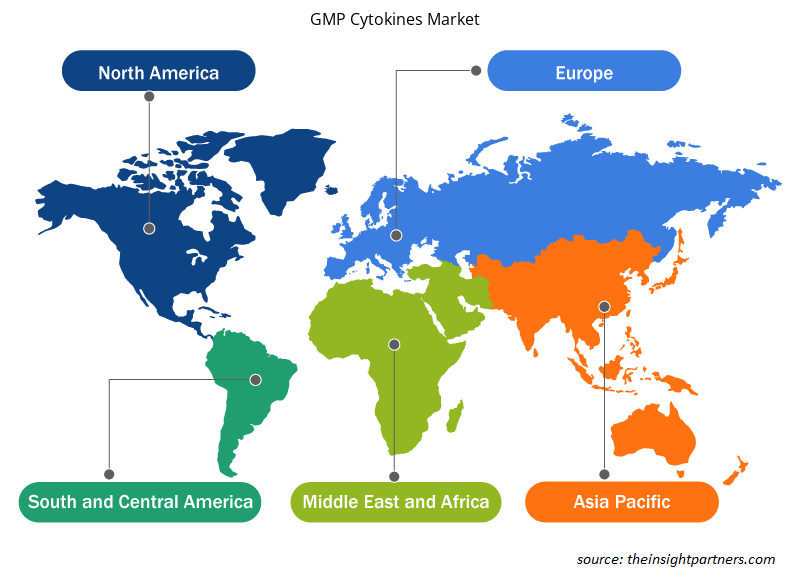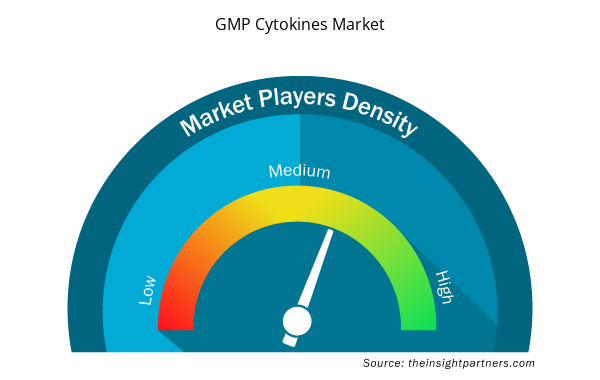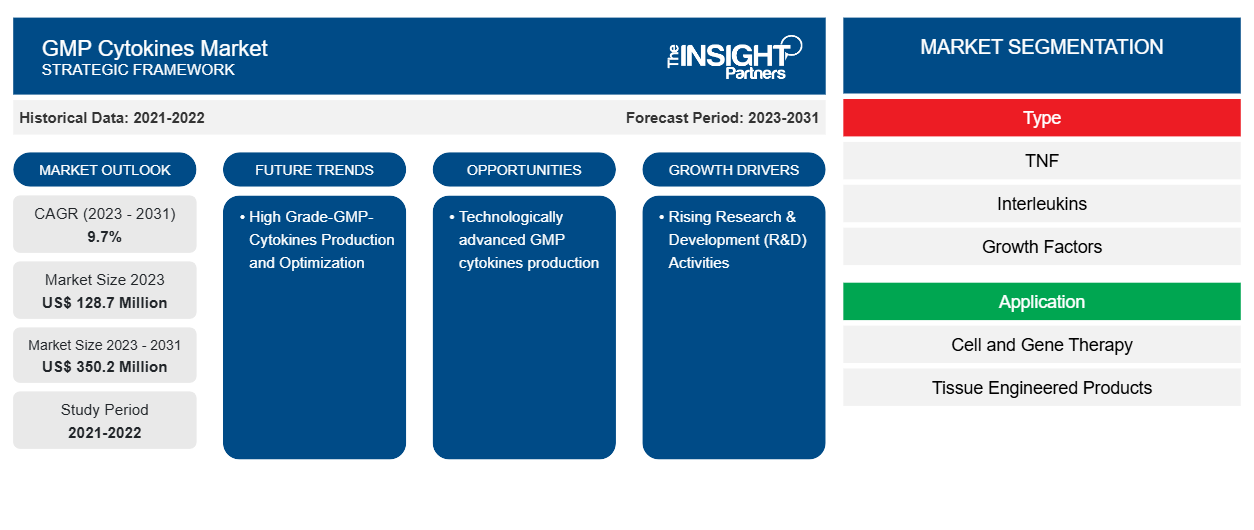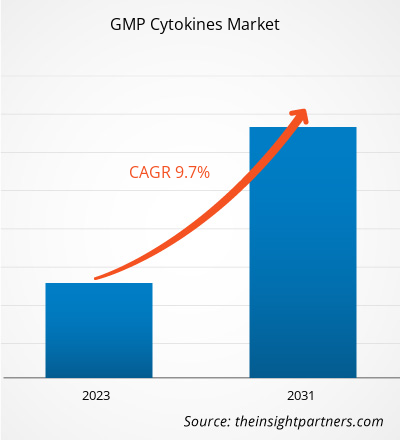GMP 细胞因子市场规模预计将从 2023 年的 1.287 亿美元增至 2031 年的 3.502 亿美元。预计 2023-2031 年市场复合年增长率将达到 9.7%。技术先进的 GMP 细胞因子生产可能仍是 GMP 细胞因子市场的一个关键趋势。
GMP 细胞因子市场分析
GMP 细胞因子在癌症治疗中的应用、将细胞因子用作新生儿败血症的潜在生物标志物以及用于干细胞治疗的细胞因子是推动市场增长的最重要因素。此外,研发 (R&D) 活动在 2021-2031 年期间进一步推动了市场增长。此外,制造商生产的高品质 GMP 细胞因子和优化将在未来几年提供丰厚的市场机会。
GMP 细胞因子市场概览
细胞因子是 T 细胞和 NK 细胞疗法制造的关键原材料。例如,PeproGMP 细胞因子在体外制造过程中提供安全性、纯度和简化的使用。此外,MACS GMP 细胞因子提供多种高活性和纯度的细胞因子,完全满足用于细胞疗法的细胞制造的高质量原材料的要求。因此,GMP 细胞因子的创新产品发布可能是推动市场增长的一个影响因素。
定制此报告以满足您的需求
您可以免费定制任何报告,包括本报告的部分内容、国家级分析、Excel 数据包,以及为初创企业和大学提供优惠和折扣
- 获取此报告的关键市场趋势。这个免费样品将包括数据分析,从市场趋势到估计和预测。
GMP 细胞因子市场驱动因素和机遇
研发活动增多利好市场
细胞因子用于临床研究,例如临床癌症治疗。例如,细胞因子刺激介导针对肿瘤的免疫反应的自然杀伤 (NK) 和 T 细胞的功能、存活和增殖。例如,MACS GMP 细胞因子产品组合在临床研究中提供体外细胞培养。因此,对于日益增长的细胞因子临床研究,制造商正在开发高标准的细胞因子。例如,用于干细胞研究的细胞因子应低内毒素,不含微生物、动物产品和潜在毒素。此外,必须过滤细胞因子以确保纯度并测试其是否具有足够的生物活性。此类 GMP 细胞因子的一个例子是通过 ScaleReady 制造生产的细胞因子“T 细胞和 NK 细胞”。GMP 细胞因子是制造 T 细胞和 NK 细胞疗法的关键原料。上述因素对 2021-2031 年 GMP 细胞因子的市场增长产生积极影响。
制造商的高级 GMP 细胞因子生产和优化——GMP 细胞因子市场的机会
目前,细胞因子制造商正在开发有效的高通量策略和有效的优化技术。BioTechne 就是这样一家专注于生产针对实体肿瘤癌症的自体T 细胞疗法的制造商。该公司寻求开发创新的细胞因子补充方法,减少细胞因子浪费,提高批次间剂量准确性,并降低工艺风险。进行了一项可行性研究,以监测细胞因子的临床效果和优化技术。此外,该公司正在努力为残留的细胞因子产品提供适合工艺的活动,消除 GMP 细胞因子浪费。因此,生产高等级 GMP 并进行有效的工艺优化最终将带来高质量的制造实践,从而提供有效的产出,并将在未来几年推动市场的发展。
GMP 细胞因子市场报告细分分析
有助于得出 GMP 细胞因子市场分析的关键部分是污染物、技术和食品类型。
- 根据类型,GMP 细胞因子市场分为 TNF、白细胞介素、生长因子等。TNF 部分在 2023 年占据了较大的市场份额。
- 从应用方面来看,市场细分为细胞和基因治疗、组织工程产品等。2023 年,细胞和基因治疗领域占据了市场主导地位。
GMP 细胞因子市场份额(按地区)分析
GMP 细胞因子市场报告的地理范围主要分为五个地区:北美、亚太、欧洲、中东和非洲、南美/南美和中美。
北美的 GMP 细胞因子市场发展显著。在北美,GMP 细胞因子市场目前处于增长阶段,并呈指数级增长。在北美,美国占 GMP 细胞因子市场的最大份额。顶级生物技术公司的存在和创新产品的推出是推动北美地区增长的最有影响力的增长因素。此外,亚太地区将在 2021-2031 年期间占据 GMP 细胞因子市场的最高复合年增长率。
GMP 细胞因子市场区域洞察
Insight Partners 的分析师已详细解释了预测期内影响 GMP 细胞因子市场的区域趋势和因素。本节还讨论了北美、欧洲、亚太地区、中东和非洲以及南美和中美洲的 GMP 细胞因子市场细分和地理位置。

- 获取 GMP 细胞因子市场的区域特定数据
GMP 细胞因子市场报告范围
| 报告属性 | 细节 |
|---|---|
| 2023 年的市场规模 | 1.287亿美元 |
| 2031 年市场规模 | 3.502亿美元 |
| 全球复合年增长率(2023 - 2031) | 9.7% |
| 史料 | 2021-2022 |
| 预测期 | 2023-2031 |
| 涵盖的领域 | 按类型
|
| 覆盖地区和国家 | 北美
|
| 市场领导者和主要公司简介 |
|
GMP 细胞因子市场参与者密度:了解其对业务动态的影响
GMP 细胞因子市场正在快速增长,这得益于终端用户需求的不断增长,而这些需求又源于消费者偏好的不断变化、技术进步以及对产品优势的认识不断提高等因素。随着需求的增加,企业正在扩大其产品范围,进行创新以满足消费者的需求,并利用新兴趋势,从而进一步推动市场增长。
市场参与者密度是指在特定市场或行业内运营的企业或公司的分布情况。它表明在给定市场空间中,相对于其规模或总市场价值,有多少竞争对手(市场参与者)存在。
在 GMP 细胞因子市场运营的主要公司有:
- 美天旎生物技术公司
- 中国义翘神州生物股份有限公司
- 澳大利亚建筑材料与计算机协会
- PeproTech 公司
- 阿克伦生物科技
- CellGenix有限公司
免责声明:上面列出的公司没有按照任何特定顺序排列。

- 获取 GMP 细胞因子市场顶级关键参与者概述
GMP 细胞因子市场新闻和最新发展
GMP 细胞因子市场通过收集一级和二级研究后的定性和定量数据进行评估,其中包括重要的公司出版物、协会数据和数据库。以下是市场创新、业务扩展和战略发展列表:
- 2024 年 3 月,工程细胞因子治疗公司 Synthekine Inc. 宣布发布 α/β 偏向性 IL-2 部分激动剂 STK-012 的 1a/1b 期临床试验。(来源:Synthekine,新闻稿)
- 2022 年 3 月,临床阶段生物制药公司 Xenco 宣布开发用于治疗癌症和自身免疫性疾病的工程抗体和细胞因子,并在 2022 年美国癌症研究协会 (AACR) 年会上展示了 XmAb 细胞因子项目的临床前数据。
- 2022年7月,山德士宣布其生物类似药“Hyrimoz”(阿达木单抗)的高浓度制剂100mg/ml(HCF)的补充生物制品许可申请(sBLA)已获美国食品药品监督管理局(USFDA)批准。该申请包括未受孤儿药独占权保护的参考药物Humira(阿达木单抗)的适应症,包括类风湿性关节炎、幼年特发性关节炎、银屑病关节炎和其他临床病症。
GMP 细胞因子市场报告覆盖范围和交付成果
“GMP 细胞因子市场规模和预测(2021-2031)”报告对市场进行了详细分析,涵盖以下领域:
- GMP 细胞因子市场规模以及范围涵盖的所有主要细分市场的全球、区域和国家/地区预测
- 市场动态,如驱动因素、限制因素和关键机遇
- GMP 细胞因子市场趋势
- 详细的 PEST/波特五力分析和 SWOT 分析
- GMP 细胞因子市场分析涵盖主要市场趋势、全球和区域框架、主要参与者、法规和最新市场发展
- GMP 细胞因子行业格局和竞争分析,涵盖市场集中度、热图分析、知名参与者和最新发展
- 详细的公司简介
- 历史分析(2 年)、基准年、预测(7 年)及复合年增长率
- PEST 和 SWOT 分析
- 市场规模价值/数量 - 全球、区域、国家
- 行业和竞争格局
- Excel 数据集


- Animal Genetics Market
- Sandwich Panel Market
- Artificial Intelligence in Defense Market
- Electronic Signature Software Market
- Semiconductor Metrology and Inspection Market
- Industrial Inkjet Printers Market
- Ceramic Injection Molding Market
- Emergency Department Information System (EDIS) Market
- Single-Use Negative Pressure Wound Therapy Devices Market
- Intradermal Injection Market

Report Coverage
Revenue forecast, Company Analysis, Industry landscape, Growth factors, and Trends

Segment Covered
This text is related
to segments covered.

Regional Scope
North America, Europe, Asia Pacific, Middle East & Africa, South & Central America

Country Scope
This text is related
to country scope.
Trends and growth analysis reports related to Life Sciences : READ MORE..
The Insight Partners performs research in 4 major stages: Data Collection & Secondary Research, Primary Research, Data Analysis and Data Triangulation & Final Review.
- Data Collection and Secondary Research:
As a market research and consulting firm operating from a decade, we have published and advised several client across the globe. First step for any study will start with an assessment of currently available data and insights from existing reports. Further, historical and current market information is collected from Investor Presentations, Annual Reports, SEC Filings, etc., and other information related to company’s performance and market positioning are gathered from Paid Databases (Factiva, Hoovers, and Reuters) and various other publications available in public domain.
Several associations trade associates, technical forums, institutes, societies and organization are accessed to gain technical as well as market related insights through their publications such as research papers, blogs and press releases related to the studies are referred to get cues about the market. Further, white papers, journals, magazines, and other news articles published in last 3 years are scrutinized and analyzed to understand the current market trends.
- Primary Research:
The primarily interview analysis comprise of data obtained from industry participants interview and answers to survey questions gathered by in-house primary team.
For primary research, interviews are conducted with industry experts/CEOs/Marketing Managers/VPs/Subject Matter Experts from both demand and supply side to get a 360-degree view of the market. The primary team conducts several interviews based on the complexity of the markets to understand the various market trends and dynamics which makes research more credible and precise.
A typical research interview fulfils the following functions:
- Provides first-hand information on the market size, market trends, growth trends, competitive landscape, and outlook
- Validates and strengthens in-house secondary research findings
- Develops the analysis team’s expertise and market understanding
Primary research involves email interactions and telephone interviews for each market, category, segment, and sub-segment across geographies. The participants who typically take part in such a process include, but are not limited to:
- Industry participants: VPs, business development managers, market intelligence managers and national sales managers
- Outside experts: Valuation experts, research analysts and key opinion leaders specializing in the electronics and semiconductor industry.
Below is the breakup of our primary respondents by company, designation, and region:

Once we receive the confirmation from primary research sources or primary respondents, we finalize the base year market estimation and forecast the data as per the macroeconomic and microeconomic factors assessed during data collection.
- Data Analysis:
Once data is validated through both secondary as well as primary respondents, we finalize the market estimations by hypothesis formulation and factor analysis at regional and country level.
- Macro-Economic Factor Analysis:
We analyse macroeconomic indicators such the gross domestic product (GDP), increase in the demand for goods and services across industries, technological advancement, regional economic growth, governmental policies, the influence of COVID-19, PEST analysis, and other aspects. This analysis aids in setting benchmarks for various nations/regions and approximating market splits. Additionally, the general trend of the aforementioned components aid in determining the market's development possibilities.
- Country Level Data:
Various factors that are especially aligned to the country are taken into account to determine the market size for a certain area and country, including the presence of vendors, such as headquarters and offices, the country's GDP, demand patterns, and industry growth. To comprehend the market dynamics for the nation, a number of growth variables, inhibitors, application areas, and current market trends are researched. The aforementioned elements aid in determining the country's overall market's growth potential.
- Company Profile:
The “Table of Contents” is formulated by listing and analyzing more than 25 - 30 companies operating in the market ecosystem across geographies. However, we profile only 10 companies as a standard practice in our syndicate reports. These 10 companies comprise leading, emerging, and regional players. Nonetheless, our analysis is not restricted to the 10 listed companies, we also analyze other companies present in the market to develop a holistic view and understand the prevailing trends. The “Company Profiles” section in the report covers key facts, business description, products & services, financial information, SWOT analysis, and key developments. The financial information presented is extracted from the annual reports and official documents of the publicly listed companies. Upon collecting the information for the sections of respective companies, we verify them via various primary sources and then compile the data in respective company profiles. The company level information helps us in deriving the base number as well as in forecasting the market size.
- Developing Base Number:
Aggregation of sales statistics (2020-2022) and macro-economic factor, and other secondary and primary research insights are utilized to arrive at base number and related market shares for 2022. The data gaps are identified in this step and relevant market data is analyzed, collected from paid primary interviews or databases. On finalizing the base year market size, forecasts are developed on the basis of macro-economic, industry and market growth factors and company level analysis.
- Data Triangulation and Final Review:
The market findings and base year market size calculations are validated from supply as well as demand side. Demand side validations are based on macro-economic factor analysis and benchmarks for respective regions and countries. In case of supply side validations, revenues of major companies are estimated (in case not available) based on industry benchmark, approximate number of employees, product portfolio, and primary interviews revenues are gathered. Further revenue from target product/service segment is assessed to avoid overshooting of market statistics. In case of heavy deviations between supply and demand side values, all thes steps are repeated to achieve synchronization.
We follow an iterative model, wherein we share our research findings with Subject Matter Experts (SME’s) and Key Opinion Leaders (KOLs) until consensus view of the market is not formulated – this model negates any drastic deviation in the opinions of experts. Only validated and universally acceptable research findings are quoted in our reports.
We have important check points that we use to validate our research findings – which we call – data triangulation, where we validate the information, we generate from secondary sources with primary interviews and then we re-validate with our internal data bases and Subject matter experts. This comprehensive model enables us to deliver high quality, reliable data in shortest possible time.


 获取此报告的免费样本
获取此报告的免费样本